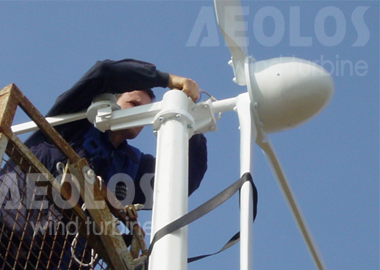Various design concepts of the horizontal-axis wind turbine are in use in this modern era. The most commonly used is a three-bladed, stall or pitch-regulated, horizontal axis machine working at near-fixed rotational speed. However, other concepts for generation that influence the wind turbine cost are also available, for instance the gearless ‘direct drive’ turbines with variable speed generator designs have a significant presence in the market. Wind turbines will normally start generating electricity at a wind speed of 3 to 5 metres per second (m/s), attain maximum power at 15 m/s and ordinarily cut-out at a wind speed of around 25 m/s.
Moreover, a typical modern wind turbine can be broken down into various major parts that also majorly affect the wind turbine cost. These parts include:
Also Read:Wind Turbines Are No Longer A Novelty
Blades: Modern turbines normally use three blades, although it is also possible to have other configurations. Turbine blades are usually made out of fiberglass-reinforced polyester or epoxy resin. However, new materials like carbon fiber are being initiated to provide the high strength-to-weight ratio required for the ever larger wind turbine blades being manufactured. Although this will restrict the size, it is also possible to manufacture the blades from laminated wood.
According to Mr. Leon Gouws of Eveready one of the leading wind turbine manufacturers in Africa, blades are very important in noise reduction, high wind speed survival and high performance energy output.
The wind turbine cost normally depends on the material used to manufacture the blades.
Rotor Hub: The turbine rotor and hub assembly rotates at a rate of 10 to 25 revolutions per minute (rpm) depending on the turbine size and design. The hub is normally attached to a low-speed shaft connected to the turbine gearbox. Modern turbines present a pitch system to best adjust the angle of the blades, attained by the rotational at the base of each blade. This enables rotor rpm to be contained and spend more time in the optimal design range. It also enables the blades to be adorned in high wind conditions to prevent damage.
Gearbox: The gearbox is housed in the nacelle. It converts the low-speed, high-torque rotation of the rotor to high-speed rotation, approximately 1,500rpm; with low-torque for input to the generator. However, ‘direct drive’ designs which do not need one are also available.
Controller: The turbine’s electronic controller surveils and contains the turbine and then gathers operational data. A yaw mechanism guarantees that the turbine always faces the wind. A potent implementation of control systems can have a major impact on energy output and loading on a turbine, and are therefore, becoming highly advanced. The controllers surveil, contain and record a huge number of parameters from rotational speeds and temperature of hydraulics, through blade pitch and nacelle yaw angles to wind speed. The wind farm operator is therefore able to have the complete information and control of the turbines from a remote location.
Generator: The generator which is contained in the nacelle converts the mechanical energy from the rotor to electrical energy. Normally, generators work at 690 volt (V) and supply three-phase alternating current (AC). Although permanent magnet and asynchronous generators are also applied in direct-drive designs, doubly-fed induction generators are typically standard.
Transformer: The transformer is normally housed inside the tower of the turbine. The medium voltage output from the generator is amplified by the transformer to between 10 kV to 35 kV; depending on the demands of the local grid.
Tower: These are usually tapered, tubular steel towers. However, concrete towers, concrete bases with steel upper sections and lattice towers are also widely utilized. The height of the tower normally depends on the site itself, rotor diameter, and the wind speed conditions of the site. Ladders and quite often elevators in modern day turbines inside the towers allow access for service personnel to the nacelle. Typically, the diameter at the base also increases with the tower height.
According to Emma Luan of AEOLOS, a wind turbine is more of a customized product, and its energy output is closely related to the wind situation, but many customers are not fully aware of this point. “Generally speaking, to install a wind turbine, the average annual wind speed should be at least 3m/s,” she adds.
 “A customer needs to focus and choose a suitable wind turbine for his particular need. This mainly depends on the wind speed at installation site, power consumption and FIT price of the local government,” affirms Emma.
“A customer needs to focus and choose a suitable wind turbine for his particular need. This mainly depends on the wind speed at installation site, power consumption and FIT price of the local government,” affirms Emma.
Most importantly, Mark L Cironi from Green Energy Technologies from the US advises customers to understand the difference between Utility Scale wind turbines from on-site decentralized wind turbines. “On-site generation should have benefits to the end user vs wind farms that utility companies install. Emerging technologies for renewable energy should customized and flow charted defining for example backup technologies, delivering an all-encompassing solution for each end user/customer,” he adds.
Mr. Zahver Tavaria of Siemens Gamesa Renewable Energy recapitulates that, increase in power demand, a decrease in LCOE and an expanding track record will strengthen the position of wind power in the region with a compounded annual growth rate of 22% in the period (2017-2026), while access to competitive financing, political instability and the strong competition of PV will remain as the main challenges for wind power development in the region.

